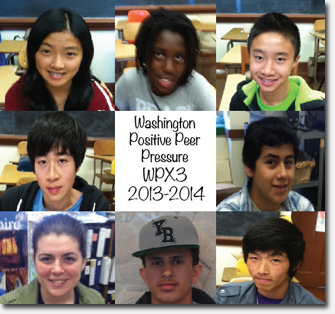 Peer Pressure.
Peer Pressure.
It’s a common theme in high school, when adolescents are struggling to define their identities and in the process, can find themselves in situations where they feel pressured by their peers to conform to popular behaviors which sometimes extend to the use of alcohol.
Early in the 2013-2014 school year, a small group of seven George Washington High School students known as the Washington Positive Peer Pressure Group (WPX3), conducted a survey among their peers about underage drinking.
What they found was that perception was definitely not reality when it came to the actual drinking habits of their classmates.
The survey, whose intent was to discover the truth about students’ relationships with underage drinking, was completed by 350 students or 15% of the student body at George Washington High School.
“We chose this topic for our survey because we felt like there were a lot of stereotypes out there associating high school students and frequent drinking,” the group wrote in their survey summary.
What they found was that GWHS students engaged in underage drinking at a far lower rate than what their peers perceived.
When respondents were asked how often they consumed alcohol in the past 12 months, 60% answered “Never”. Surprisingly, when students were asked a similar question about how frequently they perceived their peers to drink alcohol, less than 6% of students thought their peers “Never” drank alcohol in the past year.

What drives such a large gap between perception and reality? One culprit could be the media. TV shows and movies about teenagers frequently show party scenes with alcohol and binge drinking. This sort of unhealthy behavior glamorized in the media negatively brands youth and creates a general assumption that many students frequently drink alcohol – even among high school students themselves.
The survey also asked respondents what usually pressures them to drink alcohol or think about drinking alcohol. 68.9% answered that they “never feel pressured to drink alcohol”. And when asked where they get information about underage drinking from, 41% answered “Teachers”, followed by “Internet” (29%) and “Parents” (28%).

The survey results spawned a “Positive Social Norms Campaign” on campus led by WXP3 to highlight the surprising data. The group has placed posters around campus with key messages like “FACT CHECK! Over half of students at GWHS have never used alcohol in the past year!” and “Yo teachers! We get most of our information about underage drinking from you. Keep talking, we’re listening!”
They’ve also set up social media channels to facilitate conversations around topics like “What are the positive things you do to avoid the pressure to drink?” Local businesses near the school have also been asked to put up campaign posters.
GWHS Principal Ericka Lovrin was very supportive of the students’ survey and campaign.
“Their efforts are extremely valuable because the students worked hard to bring out accurate data that reflects what’s actually happening at school versus what the media puts out about teenagers,” Lovrin said.
“This work is important to us because it gives us the opportunity to change stereotypes about high school students. We want to change the norms that encourage and perpetuate underage drinking by sharing the realities and positive choices youth are making,” WXP3 wrote.
The WPX3 group is funded by the Youth Leadership Institute, a program of the Department of Public Health. Amanda Trescott, a Program Assistant for the Youth Leadership Institute, says the Social Norms campaign is a 5 year program.
“We are currently in year 4 out of 5 of program implementation. After the 5th year, data results will be compared to evaluate the trends over time to see what changes occurred among the students who attend GWHS as a result of this program,” Trescott said.
Download “Reality Check – GWHS Students Don’t Drink As Much As You Think”
Sarah B.

